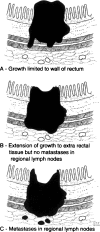Rectal cancer staging
- PMID: 20011196
- PMCID: PMC2789513
- DOI: 10.1055/s-2007-984859
Rectal cancer staging
Abstract
Rectal cancer staging provides critical information concerning the extent of the disease. The information gained from staging is used to determine prognosis, to guide management, and to assess response to therapy. Accurate staging is essential for directing the multidisciplinary approach to therapy. This article focuses on the evolution of staging systems, the rational for staging, and current methods used to stage rectal cancer.
Keywords: Rectal cancer; computed tomography; endorectal ultrasound; magnetic resonance imaging; positron emission tomography; staging.
Figures





References
-
- Jemal A, Siegel R, Ward E, Murray T, Xu J, Thun M J. Cancer statistics, 2007. CA Cancer J Clin. 2007;57:43–66. - PubMed
-
- Dukes C E. The classification of cancer of the rectum. J Pathol Bacteriol. 1932;35:323–332.
-
- Zinkin L D. A critical review of the classifications and staging of colorectal cancer. Dis Colon Rectum. 1983;26:37–43. - PubMed
-
- Lockhart-Mummery J P. Two hundred cases of cancer of the rectum treated by perineal excision. Br J Surg. 1926–1927;14:110–124.
-
- Kirklin J W, Dockerty M B, Waugh J M. The role of the peritoneal reflection in the prognosis of carcinoma of the rectum and sigmoid colon. Surg Gynecol Obstet. 1949;88:326–331. - PubMed

